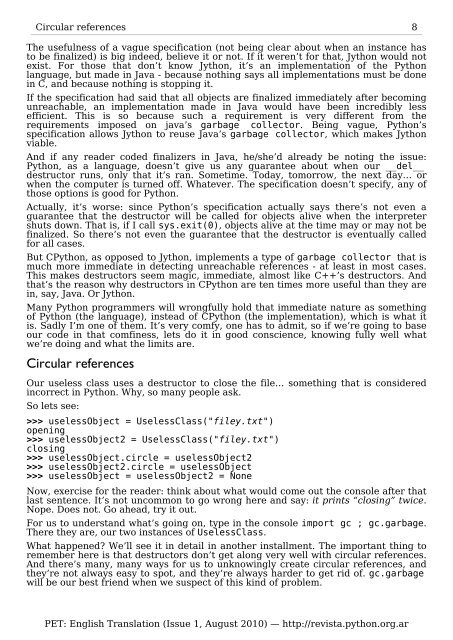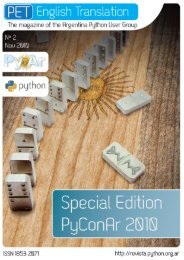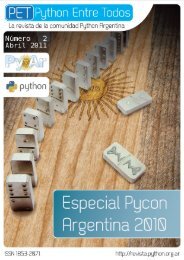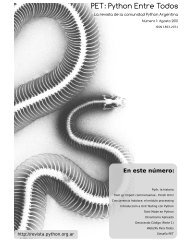A4 portrait - PET: Python Entre Todos - Python Argentina
A4 portrait - PET: Python Entre Todos - Python Argentina
A4 portrait - PET: Python Entre Todos - Python Argentina
Create successful ePaper yourself
Turn your PDF publications into a flip-book with our unique Google optimized e-Paper software.
Circular references 8<br />
The usefulness of a vague specification (not being clear about when an instance has<br />
to be finalized) is big indeed, believe it or not. If it weren’t for that, Jython would not<br />
exist. For those that don’t know Jython, it’s an implementation of the <strong>Python</strong><br />
language, but made in Java - because nothing says all implementations must be done<br />
in C, and because nothing is stopping it.<br />
If the specification had said that all objects are finalized immediately after becoming<br />
unreachable, an implementation made in Java would have been incredibly less<br />
efficient. This is so because such a requirement is very different from the<br />
requirements imposed on java’s garbage collector. Being vague, <strong>Python</strong>’s<br />
specification allows Jython to reuse Java’s garbage collector, which makes Jython<br />
viable.<br />
And if any reader coded finalizers in Java, he/she’d already be noting the issue:<br />
<strong>Python</strong>, as a language, doesn’t give us any guarantee about when our __del__<br />
destructor runs, only that it’s ran. Sometime. Today, tomorrow, the next day… or<br />
when the computer is turned off. Whatever. The specification doesn’t specify, any of<br />
those options is good for <strong>Python</strong>.<br />
Actually, it’s worse: since <strong>Python</strong>’s specification actually says there’s not even a<br />
guarantee that the destructor will be called for objects alive when the interpreter<br />
shuts down. That is, if I call sys.exit(0), objects alive at the time may or may not be<br />
finalized. So there’s not even the guarantee that the destructor is eventually called<br />
for all cases.<br />
But C<strong>Python</strong>, as opposed to Jython, implements a type of garbage collector that is<br />
much more immediate in detecting unreachable references - at least in most cases.<br />
This makes destructors seem magic, immediate, almost like C++’s destructors. And<br />
that’s the reason why destructors in C<strong>Python</strong> are ten times more useful than they are<br />
in, say, Java. Or Jython.<br />
Many <strong>Python</strong> programmers will wrongfully hold that immediate nature as something<br />
of <strong>Python</strong> (the language), instead of C<strong>Python</strong> (the implementation), which is what it<br />
is. Sadly I’m one of them. It’s very comfy, one has to admit, so if we’re going to base<br />
our code in that comfiness, lets do it in good conscience, knowing fully well what<br />
we’re doing and what the limits are.<br />
Circular references<br />
Our useless class uses a destructor to close the file… something that is considered<br />
incorrect in <strong>Python</strong>. Why, so many people ask.<br />
So lets see:<br />
>>> uselessObject = UselessClass("filey.txt")<br />
opening<br />
>>> uselessObject2 = UselessClass("filey.txt")<br />
closing<br />
>>> uselessObject.circle = uselessObject2<br />
>>> uselessObject2.circle = uselessObject<br />
>>> uselessObject = uselessObject2 = None<br />
Now, exercise for the reader: think about what would come out the console after that<br />
last sentence. It’s not uncommon to go wrong here and say: it prints “closing” twice.<br />
Nope. Does not. Go ahead, try it out.<br />
For us to understand what’s going on, type in the console import gc ; gc.garbage.<br />
There they are, our two instances of UselessClass.<br />
What happened? We’ll see it in detail in another installment. The important thing to<br />
remember here is that destructors don’t get along very well with circular references.<br />
And there’s many, many ways for us to unknowingly create circular references, and<br />
they’re not always easy to spot, and they’re always harder to get rid of. gc.garbage<br />
will be our best friend when we suspect of this kind of problem.<br />
<strong>PET</strong>: English Translation (Issue 1, August 2010) — http://revista.python.org.ar
















